Electron-Beam-Initiated Crosslinking of Methacrylated Alginate and Diacrylated Poly(ethylene glycol) Hydrogels
Abstract
:1. Introduction
2. Materials and Methods
2.1. Materials
2.2. Synthesis of Methacrylated Alginate
2.3. Degree of Methacrylation
2.4. Hybrid Hydrogel Synthesis
2.5. Infrared Spectroscopy
2.6. Infrared Microspectral Imaging
2.7. Rheology
2.8. Swelling
2.9. UV–Vis
2.10. Statistics
3. Results
3.1. Confirmation of the Presence of Both AlgMA and PEGDA in the Hydrogels
3.2. Homogeneity of the Crosslinked Networks Studied by FTIR Microspectral Imaging
3.3. Rheology
3.4. Physicochemical Characterization of the Crosslinked Hydrogels
3.5. Transparency of the Samples
4. Conclusions
Supplementary Materials
Author Contributions
Funding
Institutional Review Board Statement
Data Availability Statement
Acknowledgments
Conflicts of Interest
References
- Zhu, J.; Li, F.; Wang, X.; Yu, J.; Wu, D. Hyaluronic Acid and Polyethylene Glycol Hybrid Hydrogel Encapsulating Nanogel with Hemostasis and Sustainable Antibacterial Property for Wound Healing. ACS Appl. Mater. Interfaces 2018, 10, 13304–13316. [Google Scholar] [CrossRef] [PubMed]
- Mayet, N.; Choonara, Y.E.; Kumar, P.; Tomar, L.K.; Tyagi, C.; Du Toit, L.C.; Pillay, V. A comprehensive review of advanced biopolymeric wound healing systems. J. Pharm. Sci. 2014, 103, 2211–2230. [Google Scholar] [CrossRef] [PubMed]
- Vachhrajani, V.; Khakhkhar, P. Absorbent dressings. In Science of Wound Healing and Dressing Material; Springer: Singapore, 2020; pp. 59–68. [Google Scholar] [CrossRef]
- Alavi, M.; Nokhodchi, A. An overview on antimicrobial and wound healing properties of ZnO nanobiofilms, hydrogels, and bionanocomposites based on cellulose, chitosan, and alginate polymers. Carbohydr. Polym. 2020, 227, 115349. [Google Scholar] [CrossRef] [PubMed]
- Prasathkumar, M.; Sadhasivam, S. Chitosan/Hyaluronic acid/Alginate and an assorted polymers loaded with honey, plant, and marine compounds for progressive wound healing—Know-how. Int. J. Biol. Macromol. 2021, 186, 656–685. [Google Scholar] [CrossRef] [PubMed]
- Koehler, J.; Brandl, F.P.; Goepferich, A.M. Hydrogel wound dressings for bioactive treatment of acute and chronic wounds. Eur. Polym. J. 2018, 100, 1–11. [Google Scholar] [CrossRef]
- Afjoul, H.; Shamloo, A.; Kamali, A. Freeze-gelled alginate/gelatin scaffolds for wound healing applications: An in vitro, in vivo study. Mater. Sci. Eng. C 2020, 113, 110957. [Google Scholar] [CrossRef] [PubMed]
- Aderibigbe, B.A.; Buyana, B. Alginate in wound dressings. Pharmaceutics 2018, 10, 42. [Google Scholar] [CrossRef]
- Ionescu, O.M.; Mignon, A.; Minsart, M.; Van Hoorick, J.; Gardikiotis, I.; Caruntu, I.; Giusca, S.E.; Van Vlierberghe, S.; Profire, L. Gelatin-Based Versus Alginate-Based Hydrogels: Providing Insight in Wound Healing Potential. Macromol. Biosci. 2021, 21, 2100230. [Google Scholar] [CrossRef] [PubMed]
- Telange, D.R.; Sohail, N.K.; Hemke, A.T.; Kharkar, P.S.; Pethe, A.M. Phospholipid complex-loaded self-assembled phytosomal soft nanoparticles: Evidence of enhanced solubility, dissolution rate, ex vivo permeability, oral bioavailability, and antioxidant potential of mangiferin. Drug Deliv. Transl. Res. 2021, 11, 1056–1083. [Google Scholar] [CrossRef]
- Jafari, A.; Hassanajili, S.; Azarpira, N.; Karimi, M.B.; Geramizadeh, B. Development of thermal-crosslinkable chitosan/maleic terminated polyethylene glycol hydrogels for full thickness wound healing: In vitro and in vivo evaluation. Eur. Polym. J. 2019, 118, 113–127. [Google Scholar] [CrossRef]
- Pelras, T.; Glass, S.; Scherzer, T.; Elsner, C.; Schulze, A.; Abel, B. Transparent low molecular weight poly (ethylene glycol) diacrylate-based hydrogels as film media for photoswitchable drugs. Polymers 2017, 9, 639. [Google Scholar] [CrossRef] [PubMed]
- Ng, L.-T.; Swami, S.; Gordon-Thomson, C. Hydrogels synthesised through photoinitiator-free photopolymerisation technique for delivering drugs including a tumour-tracing porphyrin. Radiat. Phys. Chem. 2006, 75, 604–612. [Google Scholar] [CrossRef]
- Kim, S.-H.; Chu, C.-C. Fabrication of a biodegradable polysaccharide hydrogel with riboflavin, vitamin B2, as a photo-initiator and L-arginine as coinitiator upon UV irradiation. J. Biomed. Mater. Res. Part B Appl. Biomater. 2009, 91B, 390–400. [Google Scholar] [CrossRef] [PubMed]
- Benson, R.S. Use of radiation in biomaterials science. Nucl. Instrum. Methods Phys. Res. Sect. B Beam Interact. Mater. Atoms. 2002, 191, 752–757. [Google Scholar] [CrossRef]
- Hu, O.; Lu, J.; Chen, G.; Chen, K.; Gu, J.; Weng, S.; Hou, L.; Zhang, X.; Jiang, X. An antifreezing, tough, rehydratable, and thermoplastic poly (vinyl alcohol)/sodium alginate/poly (ethylene glycol) organohydrogel electrolyte for flexible supercapacitors. ACS Sustain. Chem. Eng. 2021, 9, 9833–9845. [Google Scholar] [CrossRef]
- Glass, S.; Rüdiger, T.; Griebel, J.; Abel, B.; Schulze, A. Uptake and release of photosensitizers in a hydrogel for applications in photodynamic therapy: The impact of structural parameters on intrapolymer transport dynamics. RSC Adv. 2018, 8, 41624–41632. [Google Scholar] [CrossRef] [PubMed]
- Mignon, A.; Devisscher, D.; Graulus, G.J.; Stubbe, B.; Martins, J.; Dubruel, P.; De Belie, N.; Van Vlierberghe, S. Combinatory approach of methacrylated alginate and acid monomers for concrete applications. Carbohydr. Polym. 2017, 155, 448–455. [Google Scholar] [CrossRef]
- Infrared Spectroscopy Absorption Table. 2023. Available online: https://chem.libretexts.org/Ancillary_Materials/Reference/Reference_Tables/Spectroscopic_Reference_Tables/Infrared_Spectroscopy_Absorption_Table (accessed on 12 June 2023).
- Cunningham, N. Storage Modulus (G’) and Loss Modulus (G”) for Beginners. Available online: https://www.rheologylab.com/videos/storage-and-loss-modulus-for-beginners/ (accessed on 12 June 2023).
- Koehler, J.; Wallmeyer, L.; Hedtrich, S.; Goepferich, A.M.; Brandl, F.P. pH-modulating poly (ethylene glycol)/alginate hydrogel dressings for the treatment of chronic wounds. Macromol. Biosci. 2017, 17, 1600369. [Google Scholar] [CrossRef] [PubMed]
- Sienkiewicz, A.; Krasucka, P.; Charmas, B.; Stefaniak, W.; Goworek, J. Swelling effects in cross-linked polymers by thermogravimetry. J. Therm. Anal. Calorim. 2017, 130, 85–93. [Google Scholar] [CrossRef]
- Demeter, M.; Călina, I.; Scări, A.; Micutz, M. E-beam cross-linking of complex hydrogels formulation: The influence of poly (Ethylene Oxide) concentration on the hydrogel properties. Gels 2021, 8, 27. [Google Scholar] [CrossRef]
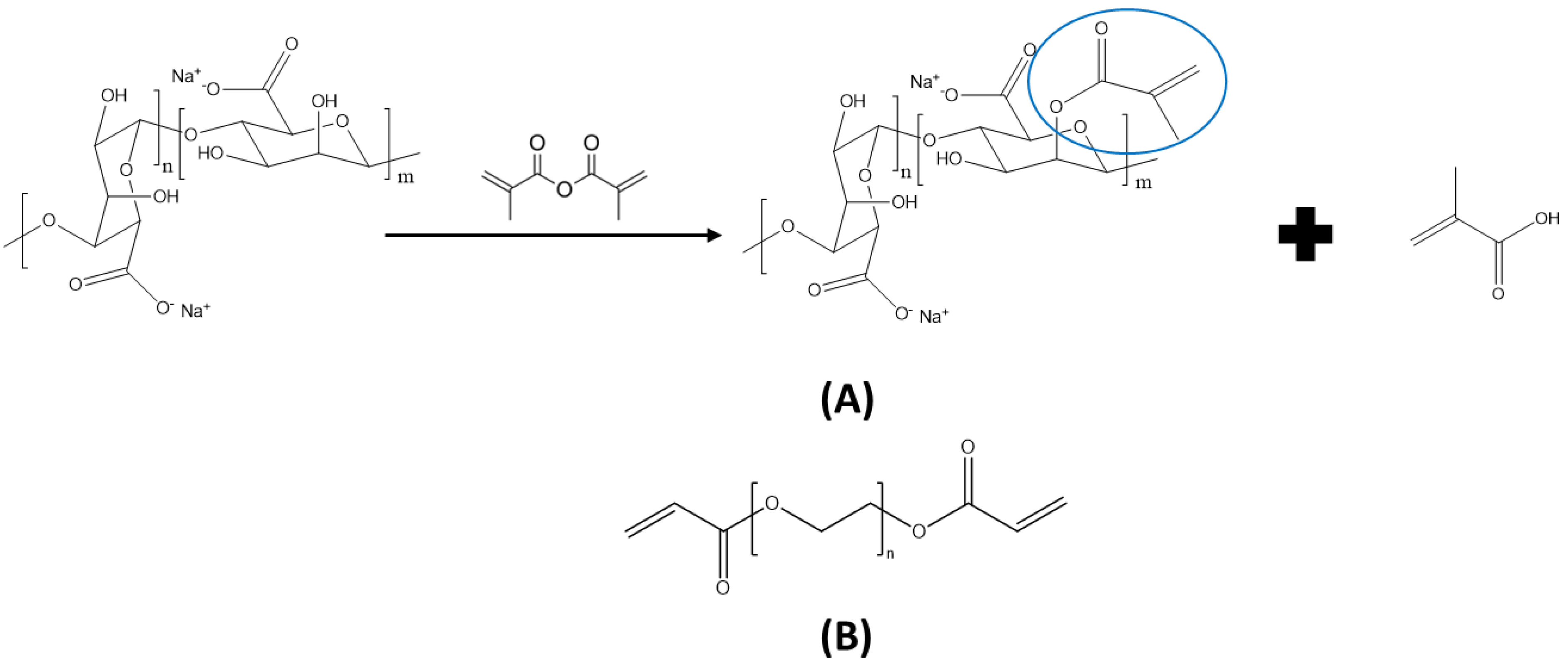

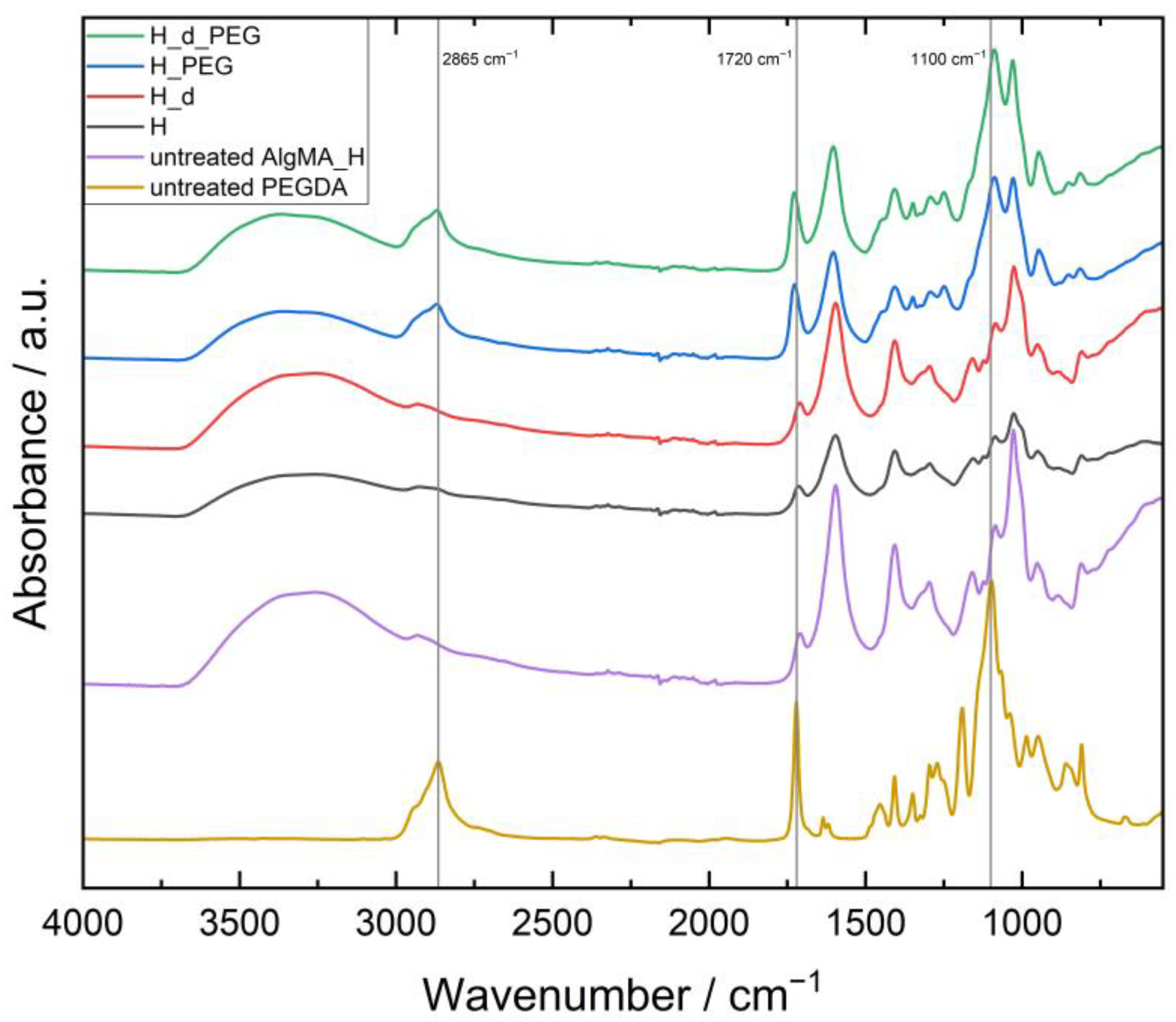

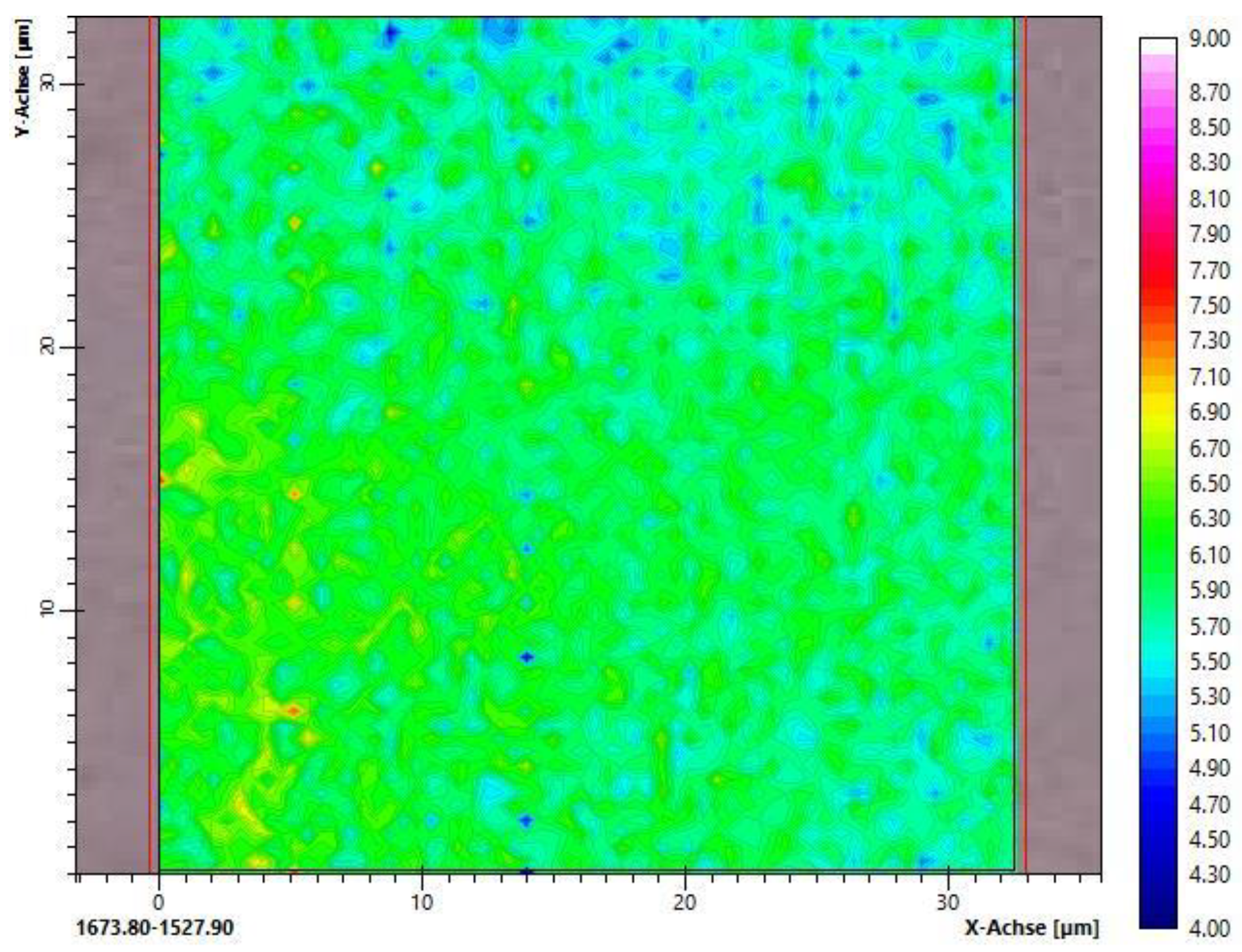
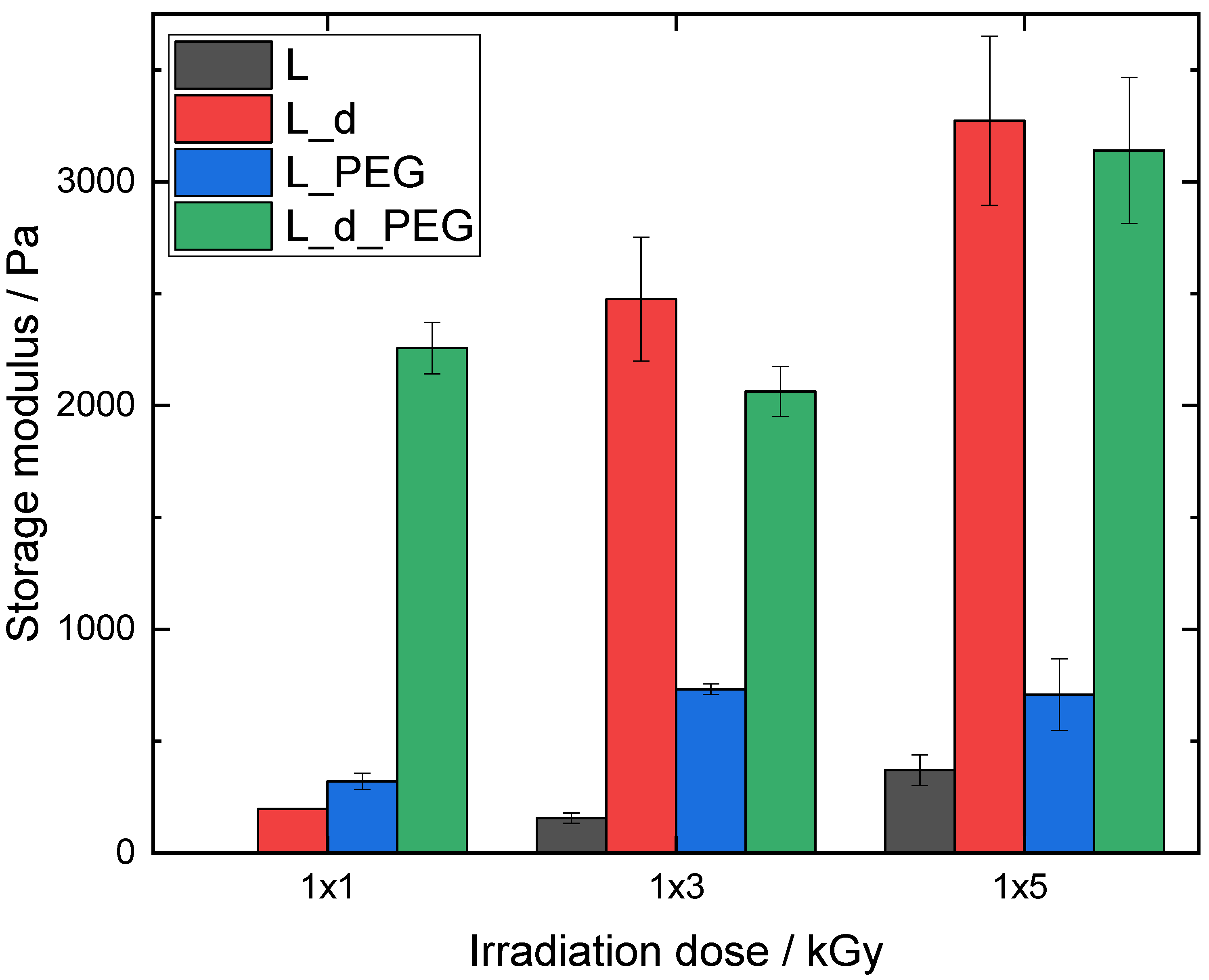
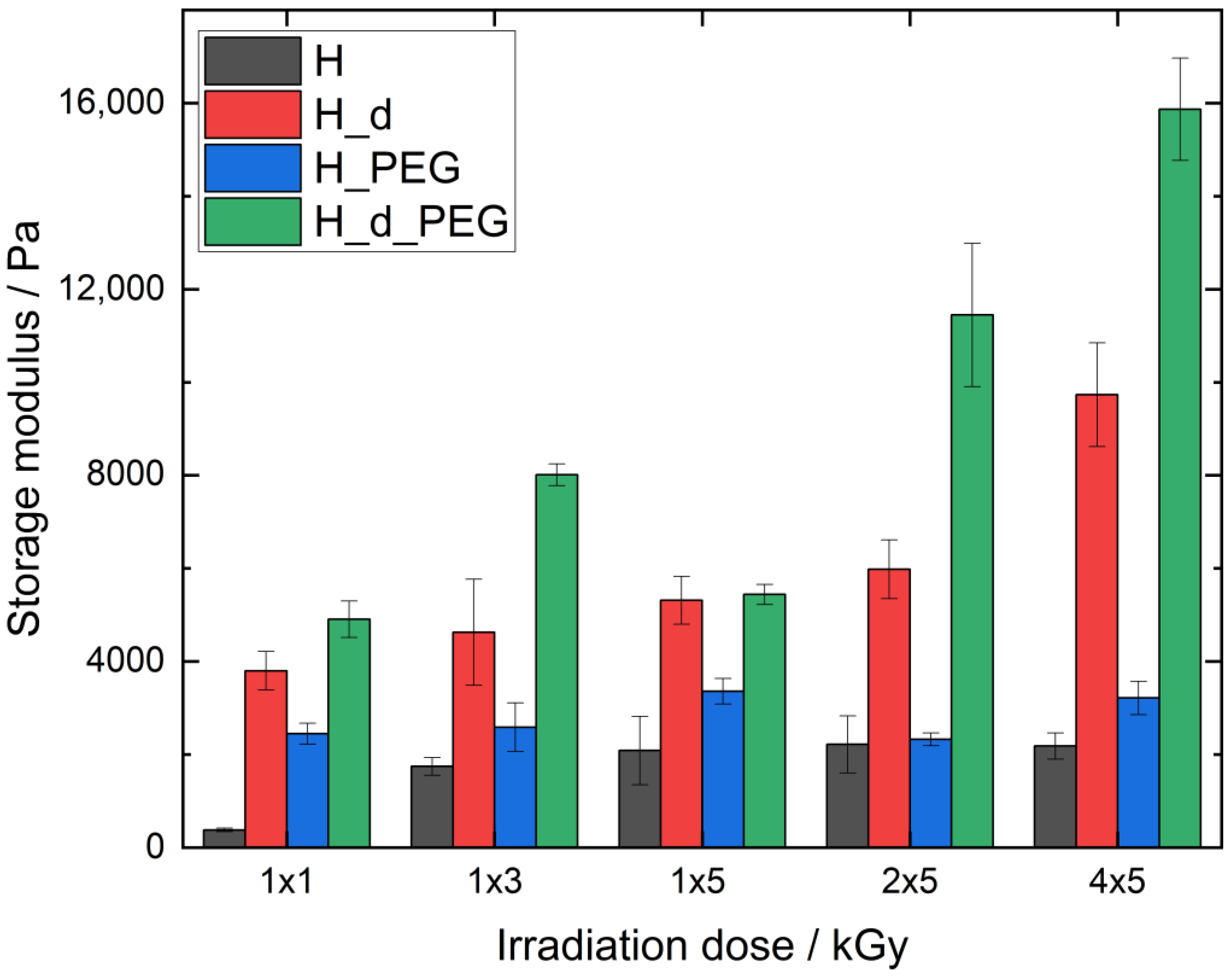
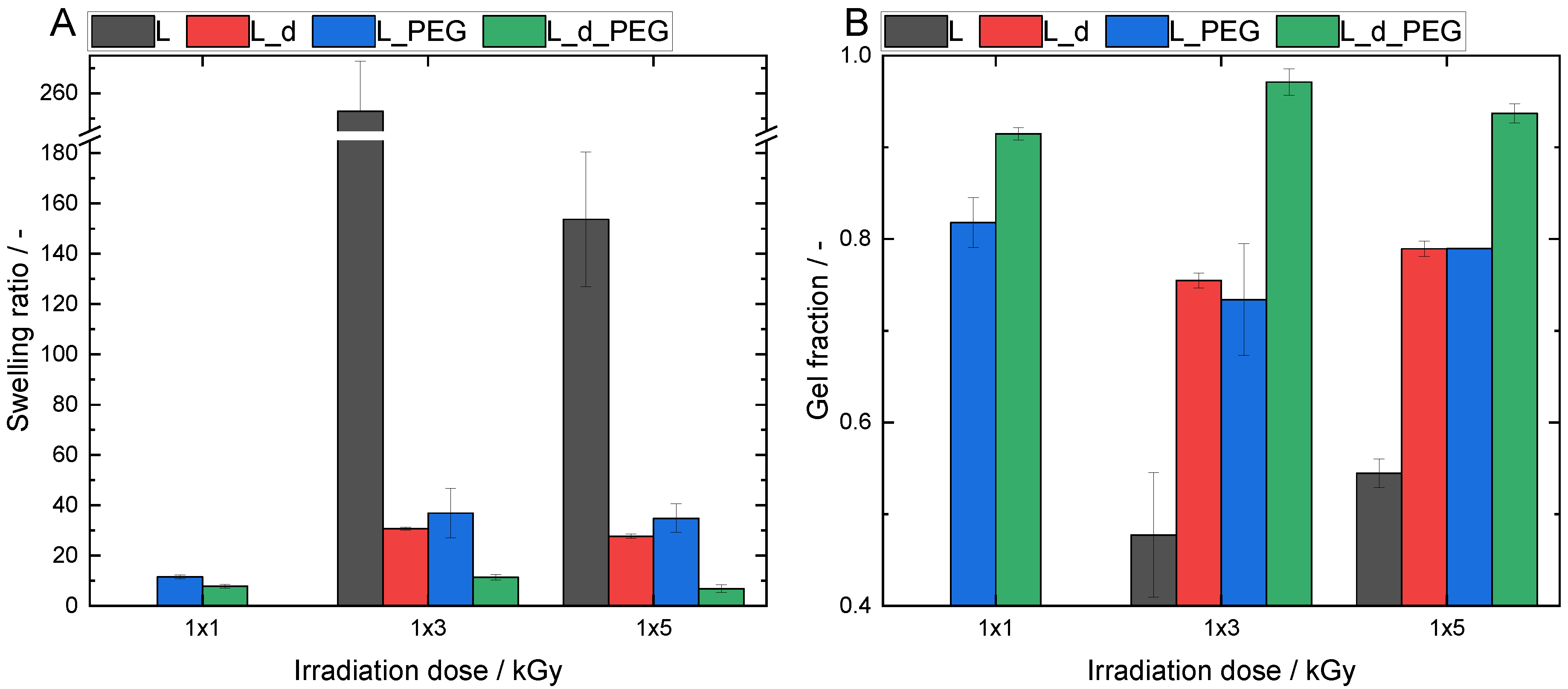
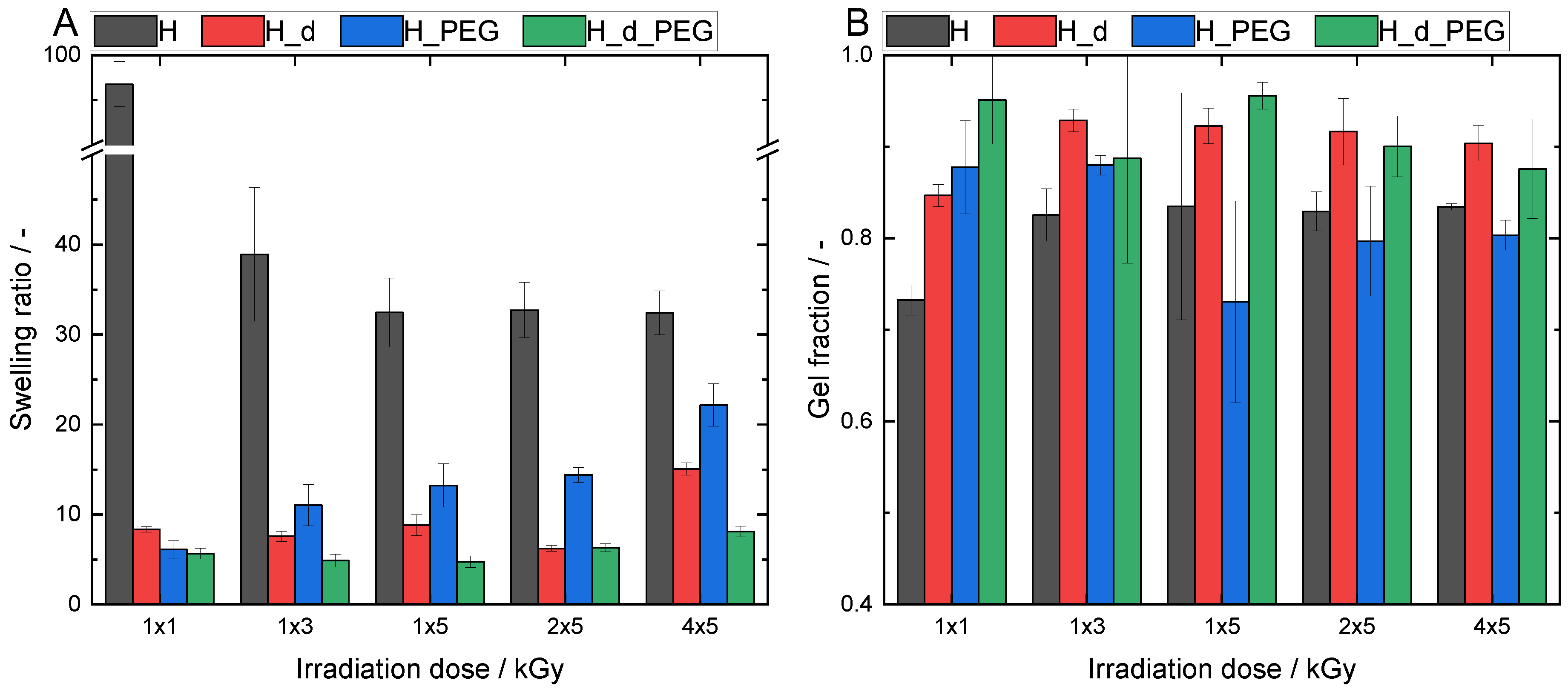

| Abbreviation | Explanation |
|---|---|
| H or L | Indication of the high or low DS of AlgMA, respectively |
| d | Total polymer concentration was 3 wt/v% in ultrapure water except when ‘d’ was added, then double the concentration was used |
| PEG | If ‘PEG’ is present in the naming, it indicates that PEGDA was added at a 1/1 weight ratio compared with AlgMA. The total concentration remained the same. If PEGDA was added by itself without AlgMA, it remains as PEGDA throughout the manuscript |
| A × B | The numbers indicated here as A and B indicate the number of irradiation cycles and the intensity of the E-beam in kGy, respectively. The used values were 1 × 1, 1 × 3, 1 × 5, 2 × 5 and 4 × 5 kGy |
| Sample | 1 × 1 kGy | 1 × 3 kGy | 1 × 5 kGy | 2 × 5 kGy | 4 × 5 kGy |
|---|---|---|---|---|---|
| L | No gel | 62.72 | 149.15 | ||
| L_d | 79.46 | 998.40 | 1320.11 | ||
| L_PEG | 128.98 | 295.28 | 285.73 | ||
| L_d_PEG | 910.66 | 832.00 | 1266.66 | ||
| H | 152.78 | 703.92 | 841.75 | 894.52 | 880.41 |
| H_d | 1532.90 | 1866.37 | 2143.37 | 2412.30 | 3927.05 |
| H_PEG | 987.31 | 1043.78 | 1355.40 | 937.89 | 1296.91 |
| H_d_PEG | 1979.66 | 3232.20 | 2194.47 | 4617.86 | 6400.54 |
Disclaimer/Publisher’s Note: The statements, opinions and data contained in all publications are solely those of the individual author(s) and contributor(s) and not of MDPI and/or the editor(s). MDPI and/or the editor(s) disclaim responsibility for any injury to people or property resulting from any ideas, methods, instructions or products referred to in the content. |
© 2023 by the authors. Licensee MDPI, Basel, Switzerland. This article is an open access article distributed under the terms and conditions of the Creative Commons Attribution (CC BY) license (https://creativecommons.org/licenses/by/4.0/).
Share and Cite
Mignon, A.; Zimmer, J.; Gutierrez Cisneros, C.; Kühnert, M.; Derveaux, E.; Daikos, O.; Scherzer, T.; Adriaensens, P.; Schulze, A. Electron-Beam-Initiated Crosslinking of Methacrylated Alginate and Diacrylated Poly(ethylene glycol) Hydrogels. Polymers 2023, 15, 4685. https://doi.org/10.3390/polym15244685
Mignon A, Zimmer J, Gutierrez Cisneros C, Kühnert M, Derveaux E, Daikos O, Scherzer T, Adriaensens P, Schulze A. Electron-Beam-Initiated Crosslinking of Methacrylated Alginate and Diacrylated Poly(ethylene glycol) Hydrogels. Polymers. 2023; 15(24):4685. https://doi.org/10.3390/polym15244685
Chicago/Turabian StyleMignon, Arn, Joanne Zimmer, Carolina Gutierrez Cisneros, Mathias Kühnert, Elien Derveaux, Olesya Daikos, Tom Scherzer, Peter Adriaensens, and Agnes Schulze. 2023. "Electron-Beam-Initiated Crosslinking of Methacrylated Alginate and Diacrylated Poly(ethylene glycol) Hydrogels" Polymers 15, no. 24: 4685. https://doi.org/10.3390/polym15244685
APA StyleMignon, A., Zimmer, J., Gutierrez Cisneros, C., Kühnert, M., Derveaux, E., Daikos, O., Scherzer, T., Adriaensens, P., & Schulze, A. (2023). Electron-Beam-Initiated Crosslinking of Methacrylated Alginate and Diacrylated Poly(ethylene glycol) Hydrogels. Polymers, 15(24), 4685. https://doi.org/10.3390/polym15244685









